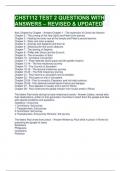Exam (elaborations)
CHST112 TEST 2 QUESTIONS WITH ANSWERS – REVISED & UPDATED
- Course
- Institution
CHST112 TEST 2 QUESTIONS WITH ANSWERS – REVISED & UPDATED Acts Chapter by Chapter - Answer-Chapter 1 - The ascension of Christ into Heaven Chapter 2 - The coming of the Holy Spirit and Peter's first sermon Chapter 3 - Healing the lame man at the temple and Peter's second sermon Chapter 4 - P...
[Show more]



